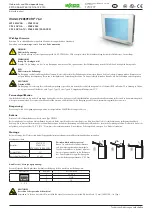
81
ENGLISH
Vigorous movement of the patient, strong ambient light, or extreme electro-surgical interference may also affect
the SpO
2
measuring accuracy.
DO NOT stare at the light of SpO
2
sensor (infrared is invisible) when switch it on, for the infrared may do harm to
the eye.
The information, such as the range of the peak wavelengths and maximum optical output power of the light by
the SpO
2
sensor can be especially useful to clinicians.
Always observe the plethysmogram (waveform), which is auto-scaled (normalized). When the measured signal
is inadequate, the waveform will be not smooth or irregular, the SpO
2
reading may be unlikely true or displayed
with “--”, and even a technical alarm will be generated. If in doubt, rely on your clinical judgement, rather than
the monitor readout.
Please do not use the SpO
2
sensor and the monitor when doing the MRI imaging, or burn may be caused by
faradism.
For disposal SpO
2
sensor, if the sterile packaging is damaged, do not use it any more.
Check the SpO
2
sensor and cable before use. Do NOT use the damaged SpO
2
sensor.
Before each use, surface-clean sensor and cable with a soft gauze pad by saturating it with a solution such as 70%
isopropyl Ethanol. If low-level disinfection is required, use a 1:10 bleach solution.
When the temperature of SpO
2
sensor is abnormal, do not use it any more.
Please do not allow the cable to be twisted or bent.
Please do not use nail polisher or other cosmetic product on the nail.
The fingernail should be of normal length.
The SpO
2
sensor cannot be immersed into water, liquor or cleanser completely, because the sensor has no
capability to resist the harmful ingress liquid.
Do not disinfect any SpO
2
sensor by irradiation, steaming, or ethylene oxide.
Carefully route cables to reduce the possibility of patient entanglement or strangulation.
☞
The clinical study for SpO
2
measurement accuracy was done on human subjects according to Standard ISO 80601-
2-61.
☞
A functional tester or SpO
2
simulator cannot be used to assess the accuracy of the oximeter or a SpO
2
sensor.
However, it can be used to check how accurately a particular oximeter is reproducing the given calibration curve.
Before testing the oximeter by a functional tester, please firstly ask the manufacturer which calibration curve is
used, if necessary, request the manufacturer for its dedicated calibration curve and download it into the tester.
10.3 Apply the Sensor
1. Select an appropriate sensor and probe according to the module type and patient category..
2. Apply the sensor to the proper site of the patient.
3. Select an appropriate adapter cable according to the connector type and plug this cable into the SpO
2
connector.
4. Connect the sensor cable to the adapter cable.
Summary of Contents for 35306
Page 2: ...2 ENGLISH Patient Monitor Operator s Manual ...
Page 21: ...21 ENGLISH Series III Front view Rear view Left view Right view 11 ...
Page 22: ...22 ENGLISH Series IV Front view Rear view Left view Right view 11 Extended Module ...
Page 171: ...2 ESPAÑOL Monitor de paciente Manual de operador ...
Page 343: ...2 FRANÇAIS Moniteur patient Manuel d utilisation ...
Page 362: ...21 FRANÇAIS Série III Vue de face Vue arrière Vue de gauche Vue de droite 11 ...
Page 519: ...2 ITALIANO Monitor Paziente Manuale d Uso ...
Page 538: ...21 ITALIANO Serie III Vista anteriore Vista posteriore Lato sinistro Lato destro 11 ...
















































